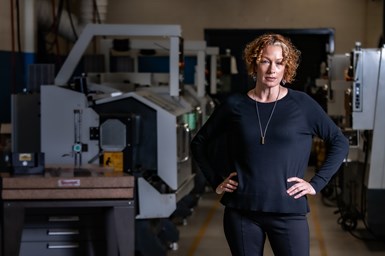Coming out of the pandemic, the challenge of hiring and retaining workers has hit the skilled trades especially hard. As companies seek ways to attract and retain workers, apprenticeships are an attractive incentive to recruit the best talent, while also investing in the company’s future.
I sat with Dr. Vikki Gordon, of Macomb Community College, located just outside Detroit, Michigan, to learn what it takes to develop a highly effective apprenticeship program. Gordon has been helping companies develop apprenticeship programs since 2010, building on more than a decade of prior experience as a tool designer in the manufacturing industry.
“A lot of shops have people that can retire anytime,” Gordon says. “So, companies are thinking about workforce development, making sure they are being competitive and preparing the workforce they need for the future.” This is where developing the right apprenticeship can be one of the best things a machine shop can do for itself and for the future of manufacturing.
1. Do use a tried-and-true model. Don’t treat it as a turnkey solution. The hallmark of a modern apprenticeship program is the combination of work experience and classroom learning. As Gordon puts it, “It is a tried-and-true model that has been going on for nearly a century.”
Dr. Vikki Gordon, apprentice coordinator at Macomb Community College, has been helping companies develop apprenticeship programs since 2010, building on more than a decade of prior experience as a tool designer in the manufacturing industry.
Photo Credit: Dave Symonds
Since the 1937 Fitzgerald Act, registered apprenticeship programs with the U.S. Department of Labor (DOL) Office of Apprenticeship have implemented this dual model. While Gordon recommends that companies register their apprenticeship programs with the DOL, she has some employers who prefer, for various reasons, to not register their programs. As Gordon points out, “If the employer designs something that is going to operate similarly to a registered apprenticeship program, they increase their chances of getting the same results in the outcome of having a highly skilled employee at the end of the program.”
Most of the trades that are registered apprenticeship programs in manufacturing are four-year programs. During the program, the apprentice will receive 8,000 hours of on-the-job training and a minimum of 576 contact hours of classroom instruction, which is about six to eight classes per year. An apprentice is both a full-time employee and a full-time student.
Perhaps the biggest mistake companies make, whether they implement a registered DOL program or an “in-house” model, is seeing an apprenticeship as simply sending an employee to school. But only going to class and then going to work does not make an apprenticeship.
While now less frequent, Gordon recalls when companies would come to her and it would quickly become apparent that they had zero plans for on-the-job training.
This leads to the biggest takeaway from my conversation with Gordon — the center of the most effective apprenticeship programs is not an educational institution nor a government agency, but the employer.
“Sometimes companies think the school or the DOL is the entity that is going to be overseeing the program. But this is their program. The employers’ involvement is the key,” Gordon says.




2. Do establish a work process. Don’t just have workers work. An effective work component for an apprenticeship is more than simply an employee going to work.
In thinking about the apprenticeship work component, start by asking three questions:
1) What equipment does the apprentice need to know how to operate?
2) What tasks and techniques do they need to master?
3) How long should they dedicate to each of those to build competency?
Gordon explains that it is best to work out how many hours are needed through repetitive practice, then lay out a schedule of timed training of so many hours every week to devote to a particular project with the apprentice.
An effective work component for an apprenticeship is more than simply an employee going to work.
In DOL parlance, this is called the “work process.” The work process covers on-the-job learning (OJL) or on-the-job training.
Below is an example of the work process/OJL from an approved DOL apprenticeship to become a master tool and die maker:
Process Hours
Power Hack Saw 200
Shaper 1,200
Lathe 1,200
Drill Press 600
Surface Grinder 500
Cylindrical Grinder 500
Internal Grinder 500
Milling Machine 1,200
Simple Die Fixture 700
Bench, Layout and Assembly 1,200
Heat Treating 200
Total 8,000
In a registered program, the employer works with the DOL to develop which general processes are necessary and the number of hours dedicated to each. With an “in-house” program, a machine shop can decide the processes it wants to implement. But, either way, having an itemized list of processes and associated number of hours is essential for any effective apprenticeship. The actual specific tasks and techniques to be learned within these processes is completely up to the employer, whether they are doing a registered or “in-house” program.
Gordon points out that it is the relationship of a master to an apprentice that truly makes the work process more than only working hours. She says it is a proven successful model: an apprentice learning under a master with a deliberate intentional process for specific skills identified and laid out between the company and the employee.
The DOL model calls for one master to one apprentice. The selection of a master is critical, according to “The master is someone to guide [their apprentice] through their on-the-job training,” Gordon says. “They have someone to go to, to talk about their work experience and how their education relates to that.”
With all this being done during the workday, the master must balance the need to get that day’s job done while preparing the apprentice for the jobs of tomorrow.
3. Do participate in building an educational program. Don’t just send apprentices to class.
While companies are often quite comfortable with on-the-job training, the classroom component can sometimes feel foreign to them. Here, Gordon recommends resisting the urge to take a back seat. For instance, if a machine shop is working with a community college and the classes needed aren’t being offered, shops should talk to the school.
“Community colleges are very good at working with the local businesses to specifically address the skills they need their employees to develop,” Gordon explains. “Community colleges are uniquely positioned to be this kind of education — to address the related instruction for apprenticeships.”
What is important is that the employer stays involved.
Community colleges are only one of four general sources companies can tap into to meet the educational demands an effective apprenticeship. Correspondence schools, corporate training programs and in-house classrooms are the other three educational sources.
Community colleges offer a quality educational experience and typically have machining equipment on-site. Additionally, if a business is implementing a registered DOL program, there are often federal and state grants that will help subsidize the costs associated with an apprenticeship. Local and state workforce development boards, along with the community college itself, can help a company apply for these grants. Gordon estimates that almost 75% of the companies that she works with are receiving grants or other outside funding.
Correspondence schools can also often satisfy the educational requirements set by the DOL. However, these programs lack the hands-on experience that community colleges offer and may not be able to offer college credits to the apprentice.
Corporate training programs tend to be intense, all-day and multiday events. While these programs can be costly and cause the employee to be out of the shop for up to a week, what you get in return is an employee with a deeper understanding of the exact equipment you are using. These programs may not satisfy the DOL educational requirement.
Finally, a company may decide to simply teach the classes themselves. This is mostly done for simple, qualifying classes such as for OSHA/health and safety or specific state qualifications such as for a forklift license. In the eyes of the DOL, these classes also may not satisfy the educational requirement.
An effective apprenticeship might use one or all of the above resources. What is important is that the employer stays involved. Below is an example of a typical DOL educational curriculum. Again, dealing with a government agency, related technical instruction (RTI) is how the DOL refers to the educational component. An RTI-approved breakdown might look something like this:
General Course Topics Number of Courses
Mathematics 2
Draft & Design 2
Metal Craft Theory 6
CNC Essential and Operations 2
Welding 2
Quality Control and Inspection 2
Under “Mathematics,” an apprentice might take a course in algebra and then another course in trigonometry, with each of these classes working toward satisfying the educational requirement of the apprenticeship. One of the advantages of using a community college or correspondence school is they often have experience building a program that satisfies DOL education criteria. Classes, though, must primarily satisfy the company’s needs. Be sure to work with an education provider to build a program that results in the kind of worker needed.
4. Do Reap the benefits!
The more a company takes ownership of its apprenticeship program, the more it will benefit from it. Apprenticeships are a commitment by both employer and employee — four years of hard work, long days and nights, in the classroom and on the shop floor. It is the coordinated time, invested by everyone involved, that transforms an apprentice into a skilled machinist.
Related Content
Gift a 3D Printer to an Employee?
Some shops have purchased inexpensive polymer 3D printers for their operations. Does it make sense to take this a step further and give (or loan) a sharp young employee one to experiment with at home? This small investment could pay off for your shop in different ways.
Read MoreManufacturing Skills Training: Virginia Martinez and Laiken Carrillo
Roles of Women in Manufacturing Series: A precision machining career starts with skills. Virginia and Laiken share their journey and how they help prepare the next generation.
Read MoreCNC Machine Shop Employment Positions to Consider Beyond Machine Operators
Many machine shops have open machine operator positions to fill. But does it make sense for shops to also seek automation engineers, IT managers and assembly personnel?
Read MoreApplying a Healthy Approach to Employee Investment
Service Center Metals’ on-site health center offers its employees and their families free same-day health care and, in return, the employer is gaining many benefits including a healthier workforce and attracting potential employees.
Read MoreRead Next
Is the German Apprenticeship Model the Answer for U.S. Manufacturing?
This machine tool builder president and CEO is an ardent proponent of the German apprenticeship model and believes this concept could be applied here in the United States to address the skilled labor shortage.
Read MoreUS Should Consider German Apprenticeship Model
The German apprenticeship model is effective in Germany. But can it be successfully transplanted here? “The Atlantic” recently posted an article discussing the German Apprenticeship model.
Read MoreAdvertising an Apprenticeship Program
Cox Manufacturing takes unusual steps to recruit new employees into its apprenticeship program.
Read More























